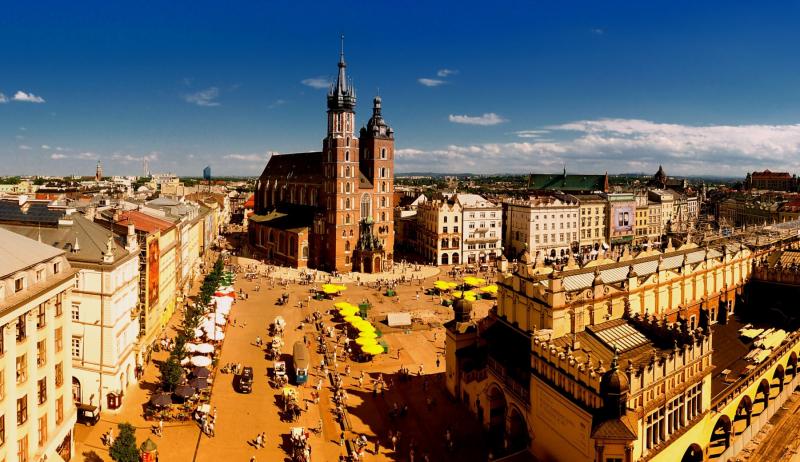
Kraków, A Cultural Haven
By Laura Blake
More than five million people visit Poland’s ‘second city’ each year, but take a look around and you come to realise that there is absolutely nothing second rate about the place. As one of Poland’s oldest cities, Kraków’s past is impressively well preserved in its well-travelled streets and grand architecture. Its museums and art galleries are filled with the finest renaissance art imaginable, making Kraków a cultural haven.
Old Town
A visit to Old Town will overwhelm your senses. Kraków commands an eye-catching skyline due to its many towers, the grandest of which is Old Town’s Town Hall Tower. Despite having undergone several reconstructions over the years, the tower still retains much of its 13th Century gothic architecture. Its lookout platform stands nearly 70 metres in the air, and gives visitors a spectacular view that reaches the Kraków horizon.
Take a trip back to the times of courageous princes and fire-breathing dragons, with a visit to Wawel castle. The stronghold can be found on Wawel Hill; said to be the lair of the ferocious Wawel dragon. If you wish to get a better picture of this fiendish foe, visit the nearby Wawel Cathedral, where you will find ‘authentic’ dragon bones hanging from the walls. A menacing statue of the scaly monster sits on the hill; along with a plaque commemorating the slaying of the beast by Prince Krakus.
Finally, why not head out after dark and take a romantic stroll along Old Town’s cobbled streets, in the company of beautifully designed buildings illuminated by skyward spotlights.
Kazimierz
Kraków’s Jewish district is a located near the Vistula River, and has been the home of Kraków’s main Jewish community since the 14th Century. The thriving community remained in Kazimierzuntil they were forcefully relocated to the nearby Podgorze ghetto by the Nazis during the Second World War. Unfortunately, the once lively town fell into ruin, and remained in a constant state of repair until Hollywood director Steven Spielberg chose the location for his World War II epic Schindler's List in 1993. Spielberg chose the district for its authenticity, and the interest generated by the multi Oscar-winner led to its massive renovation.
Today, Kazimierz is once again full of life. Since the turn of the century, an innumerable amount of trendy bars and quaint cafes have sprung up throughout the district, contributing to its animated nightlife. However, meandering through its enchanting narrow streets, you are still able to catch glimpses of the quarter’s colourful past. The most striking reminder is undoubtedly Tempel Synagogue, which will leave you awestruck thanks to its chalk-like neo-Renaissance façade. You will undoubtedly be drawn to enter by the exquisite chandeliers which hang from the structure’s high ceilings, generating a welcoming glow.
If you’re keen to try some of the local cuisine, Kazimierz’s bustling outdoor market is a real find. Inspect each wooden stall from the most delicious home-baked biscuits, mulled wine, and all kinds of whimsical ornaments and trinkets.
Nowa Huta
Nowa Huta is located on Kraków’s most eastwardly frontier, and is one of the city’s largest and most populous districts. Translating into English as “The New Steel Mill”; the city has strong ties to Poland’s communist past. However, Polish Socrealism (Socialist Realism) isn’t the defining characteristic of Nowa Huta’s illustrious history. The Wanda mound is a monument erected to mark the final resting place of Princess Wanda. The short climb to the top is filled with magnificent sights of the lush greenery that encircles the mound. Wanda was the 8th Century daughter of dragon-slaying founder of Kraków Prince Krakus, and the story goes that Wanda took her own life to avoid the compulsory marriage of a brutal knight.
Fast-forward twelve centuries with a trip to the Kraków Historical Museum, which charts Nowa Huta’s existence since 1949. Gain an in-depth account of the Soviet Union’s occupation of the area after the war, and their construction of Europe’s biggest steel mill. The city itself was designed around the mill, combining an array of architectural styles. Walking its streets you are reminded of the city’s communist era with the egalitarian apartment buildings which are scattered throughout. These social realism inspired designs are intertwined with classy, refined renaissance architecture, much of which is found in Nowa Huta’s centre square.
Round Up
There is so much to discover in this hive of cultural activity you will be compelled to return again and again. Its historical appeal and bewitching aesthetics make Kraków a premier tourist destination; you simply need to visit and discover its charms for yourself.
Share this article:




















